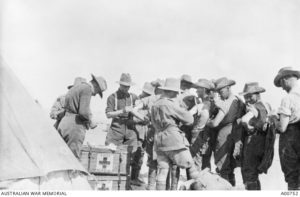Thursday May 30th, 1918
Work 7am to 11am. Raining hard and cold weather. French 15s again bumping Johnny. Innoculated against cholera. Joe Harrison goes with Lieutenant Wallwork down to base. Johnny bumps dirty H.E. (High Explosive shells) in our camp.
Death & Disease
Today Frank is inoculated against cholera and bombed by the enemy. In the major wars of the 19th century, deaths of soldiers from disease were significantly higher than those from combat. These included the Peninsular Wars, the American Civil War, the Crimean and the First and Second Boer Wars.¹
In the early 20th Century these statistics were reversed, starting with the Russo-Japanese War in Asia in 1904-05, when Japanese deaths from disease were 35%. This trend continued with the Great War, where the ratio of deaths from combat and disease amongst troops from all sides was roughly 2:1.¹ As we know, this wasn’t the case in all theatres of war, with casualties, not necessarily deaths, in Macedonia being 20:1 the other way. Unfortunately too, it wasn’t all about advances in medical science and health. Some of the shift was down to the proficiency with which modern weapons of war dispense death and destruction.
Cholera Jabs

Underscoring this, Professor Cox in a lecture in 2014, said of the medical profession at the outbreak of war, ‘In 1914 many of the doctors had graduated in the 1880s, well before the germ theory had become universally accepted, and still believed that diseases arose from foetid conditions and this was confirmed, in their minds, by the observation that disease was most prevalent in the stinking, waterlogged trenches that permeated much of Europe.’ ¹
Indeed the roles of Directors of Hygiene and Pathology were only created on the staff of the Director General of the Army Medical Service in 1919.²
That said, almost all British troops were vaccinated against typhoid throughout WWI. There was also a vaccine for cholera and some other diseases by 1914. However according to Cox, ‘they appear to have been used randomly without any obvious strategic plan’.¹
The Battalion diary has been carrying warnings that troops who had diarrhea should not prepare food or handle water supplies. These are the only ways in which to transmit cholera. There may not have been a strategic plan for vaccinations against cholera but, luckily for Frank and his comrades, at least the 13th Manchesters received them today. Similarly, the photograph shows men of the Australian 21st Battalion receiving cholera vaccinations in Egypt prior to leaving for Gallipoli in 1915.*
13th (Service) Battalion War Diary – 30th May 1918 – Sporan
Our artillery carried out registration of our own main line barrage. Enemy fired a few rounds on Dautli Village, Bastion Hill, Avondale, Glengarry and Basin Hill. During the night there was considerable artillery activity on the eastern side of the Pal ridge and also opposite the 26th Divisional front east of the Vardar probably near Mucukovo. This brought out the enemy searchlights opposite No 1 Sector and near the Vardar. Our aeroplanes showed their usual activity over the enemy lines. Enemy planes were inactive. Nothing was seen or heard of the enemy by patrols.
References & Further Reading
¹’The First World War: Disease, The Only Victor‘, transcript of lecture by Professor Francis Cox at Gresham College, 2014, both quotations from page 4, other elements throughout the transcript.
² ‘History of the Great War Medical Services, General History’, Volume 1, by Major-General Sir WG Macpherson, HMSO, 1921, page 65
* photograph copyright Australian War Memorial


